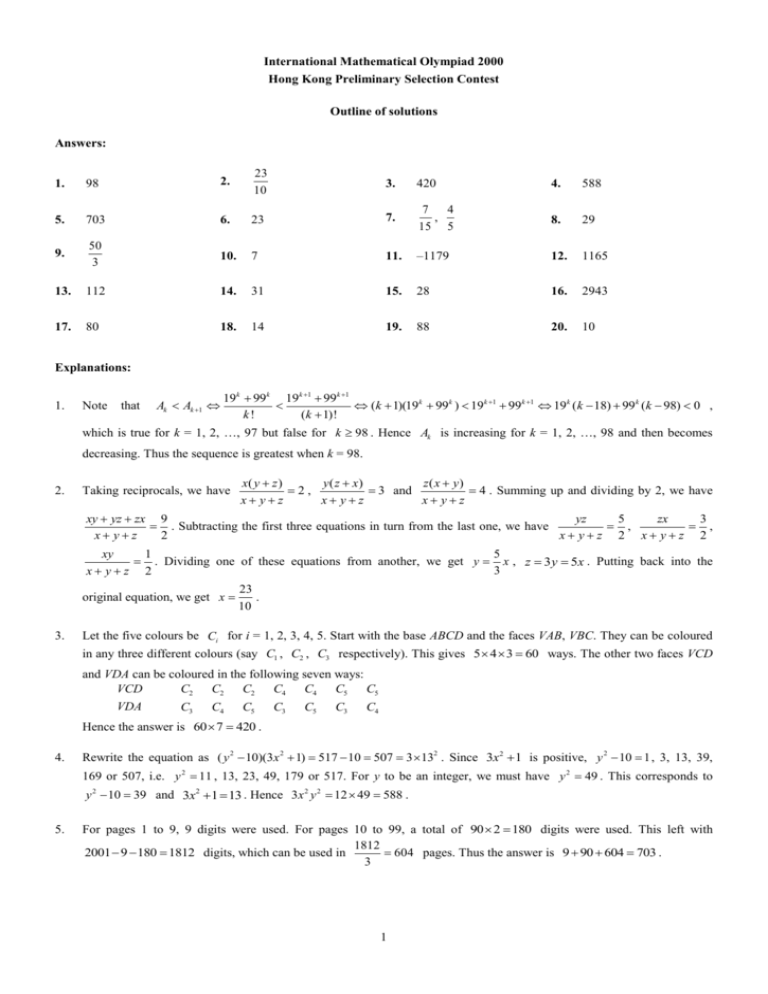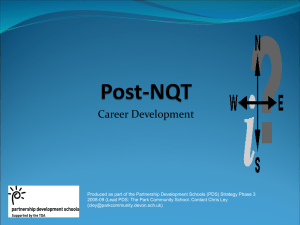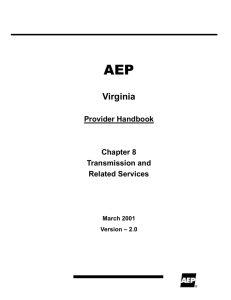se_99-00_sol
advertisement

International Mathematical Olympiad 2000
Hong Kong Preliminary Selection Contest
Outline of solutions
Answers:
1.
98
2.
23
10
3.
420
4.
588
5.
703
6.
23
7.
7 4
,
15 5
8.
29
9.
50
3
10.
7
11.
–1179
12.
1165
13.
112
14.
31
15.
28
16.
2943
17.
80
18.
14
19.
88
20.
10
Explanations:
1.
Note
that
Ak Ak 1
19k 99k 19k 1 99k 1
(k 1)(19k 99k ) 19k 1 99k 1 19k ( k 18) 99k ( k 98) 0 ,
k!
(k 1)!
which is true for k = 1, 2, …, 97 but false for k 98 . Hence Ak is increasing for k = 1, 2, …, 98 and then becomes
decreasing. Thus the sequence is greatest when k = 98.
2.
Taking reciprocals, we have
x( y z )
y ( z x)
z( x y)
2,
3 and
4 . Summing up and dividing by 2, we have
x yz
x yz
x yz
xy yz zx 9
yz
5
zx
3
. Subtracting the first three equations in turn from the last one, we have
,
,
x yz
2
x yz 2 x yz 2
5
xy
1
. Dividing one of these equations from another, we get y x , z 3 y 5x . Putting back into the
3
x yz 2
original equation, we get x
3.
23
.
10
Let the five colours be Ci for i = 1, 2, 3, 4, 5. Start with the base ABCD and the faces VAB, VBC. They can be coloured
in any three different colours (say C1 , C2 , C3 respectively). This gives 5 4 3 60 ways. The other two faces VCD
and VDA can be coloured in the following seven ways:
VCD
C2 C2 C2 C4 C4 C5 C5
VDA
C3 C4 C5 C3 C5 C3 C4
Hence the answer is 60 7 420 .
4.
Rewrite the equation as ( y 2 10)(3x 2 1) 517 10 507 3 132 . Since 3x2 1 is positive, y 2 10 1 , 3, 13, 39,
169 or 507, i.e. y 2 11 , 13, 23, 49, 179 or 517. For y to be an integer, we must have y 2 49 . This corresponds to
y 2 10 39 and 3x2 1 13 . Hence 3x 2 y 2 12 49 588 .
5.
For pages 1 to 9, 9 digits were used. For pages 10 to 99, a total of 90 2 180 digits were used. This left with
1812
604 pages. Thus the answer is 9 90 604 703 .
2001 9 180 1812 digits, which can be used in
3
1
6.
Suppose the (n – 3) integers begin with k, then n! k (n k 4) implies 2 (k 1) (n 1) (n k 4) .
Since 2 3 4 = 24, so k = 5, n = 23 is possible. For k = 6, 2 3 4 5 (n 1)( n 2) .
For k 7 , n 24 , we have (2 3 4 5) [6 (k 1)] 25 26 [27 (k 20)] (n 1) (n k 4) .
So there is no solution for n 24 .
15 x 7 5 6 x 15 x 7
41
9
1 15 x 7 13
15x 7 5 6 x
1
x
. Since
is
5
8
5
90
10
15
5
10
5
8
15 x 7
7
4
0 or 1, giving x
an integer,
or .
5
15
5
7.
The equation implies
8.
Let the sides of the triangle be (n 1) , n and (n 1) . Then we have (n 1) n (n 1) 100 and (n 1) n n 1 .
These imply 3 n 33 . For the triangle to be acute, n 2 (n 1)2 (n 1) 2 0 n 4 . So n = 5, 6, …, 33 have the
required properties, and the answer is 29.
9.
Construct CE // BD to meet AD produced at E. Since AC
= 5, CF = 4, we have AF = 3. Note that ACE = 90, so
3 AF AC
5
20
CE
ACF ~ AEC and
.
4 CF CE CE
3
Hence [ABCD] = [ABC] + [ADC] = [ABC] + [CDE] =
1 20
50
[ACE] 5
.
2 3
3
D
A
F
B
E
C
10. Let EC = x, BE = y and ED = z. Note that EDC = DBC = CAD, so DCE
CD EC
4
x
. This gives x = 2. By the triangular
~ ACD. Hence
, or
CA DC
6 x 4
inequality, y z 4 4 8 . Since ABCD is a cyclic quadrilateral, by the
A
power chord theorem, yz 6x 12 . So {y, z} = {3, 4} and BD = x + y = 7.
6
y
B
4
z
E
x
D
4
C
11. Let a1 x and a2 y . Then a3 y x , a4 x , a5 y , a6 x y , a7 x and a8 y . Hence the sequence
is a cyclic period of 6. Note also that the sum of any 6 consecutive terms is zero. Let S n denote the sum of the first n
terms. Then 1997 S1588 S6264 4 S4 2 y x and 1588 S1997 S63325 S5 y x . Solving, x 1179 and
y 409 . Thus S1999 S63331 S1 x 1179 .
12. Clearly n 7! . Let n a 6! b 5! c 4! d 3 e 2! f 1! with a 6 , b 5 , c 4 , d 3 , e 2 and f 1 .
Putting this into the original equation, we get 1237a 206b 41c 10d 3e f 1999 . Solving for integer values of the
variables, we get (a, b, c, d, e, f) = (1, 3, 3, 2, 0, 1). As a result, n 1165 .
13. Taking reciprocals, we have
13 n k 15
6 k 7
. Multiplying each term
. Subtracting one from each term, we get
7
n
8
7 n 8
by 56n, we have 48n 56k 49n . If n 56 2 112 , there are at least two multiples of 56 between 48n and 49n. For
n 112 , k is unique since 48 112 56 96 56 97 56 98 49 112 .
14. Note that 1 2
61 1891 1922 and 1 2 62 1953 1922 . Hence the book consists of 61 pages, and the
page number mistakenly added twice is 1922 1891 31 .
2
15. Let S be the sum of the remaining numbers. Then S (n 4) 51.5625 , or 16S 825(n 4) . Hence n 4 (mod 16).
Also,
(1 2
n) n (n 2) ( n 4) ( n 6)
(1 2
51.5625
n4
n) 2 4 6 8
. Solving the inequalities and
n4
using the fact that n is an integer, we have 99 n 106 . Thus n = 100. Let x be the largest integer removed. Then
(1 2 100) x ( x 2) ( x 4) ( x 6) 51.5625 (100 4) . This gives x 28 .
16. In base 3, the sequence is 1, 10, 11, 100, 101, 110, 111, … Since 200 in base 2 is 11001000, the 200th term is 11001000
in base 3, or 2943.
E
17. Produce BA to E and take D on AC such that AE = AD = AP = 8. Note
that APD = ADP, AEP = APE and BAP = 2 AEP. Now
APD = APC – CPD = B + 2 AEP – CPD, ADP = C +
CPD = B + CPD. Since APD = ADP, we have AEP = CPD.
CP BE
Thus CPD ~ BEP and so
. As a result, we have
CD BP
PB PC CD BE (12 8)(12 8) 80 .
A
D
B
P
18. Let ABD . Then AC BD 10(sin cos ) 10 2 sin( 45) .
C
D
3
3
90 . Hence 90 45 cos 1 45 135 .
5
5
Therefore, the maximum value of sin( 45) is maximum when
Now 45 cos 1
cos 1
3
3 4
, and the maximum value of AC + BD is 10 14 .
5
5 5
C
A
B
19. By symmetry, we need only consider the northeast quadrant. Suppose that the circle is centred at (0, 0). For the 36 unit
squares, consider the coordinates of their northeast vertices (p, q). The square lies completely inside the circle if and only
if (p, q) lies inside or on the circle, i.e. p 2 q 2 62 . Now p can take the values 1, 2, …, 6 and the same holds for q. We
find that for the following 14 values of (p, q): (6, 6), (6, 5), (6, 4), (6, 3), (6, 2), (6, 1), (5, 6), (5, 5), (5, 4), (4, 6), (4, 5), (3,
6), (2, 6) and (1, 6), the square does not lie completely inside the circle. Hence, 62 14 22 unit squares in the northeast
quadrant lie completely inside the circle. Thus the answer is 22 4 88 .
20. Partition the first 91 positive integers into the following sets: A1 {1} , A2 {2, 3} , A3 {4, 5, 6} , A4 {7, 8, 9, 10} ,
A5 {11, 12,
, 16} , A6 {17, 18,
, 25} , A7 {26, 27,
, 39} , A8 {40, 41,
, 60} and A5 {61, 62,
, 91} . If we
3
2
or smaller than . Hence
3
2
2
k 9 . For k 10 , by the pigeon-hole principle, two numbers come from the same set and their ratio lies between
3
3
and . Hence the answer is 10.
2
choose one number from each set, then the ratio of any two of them is either greater than
3








